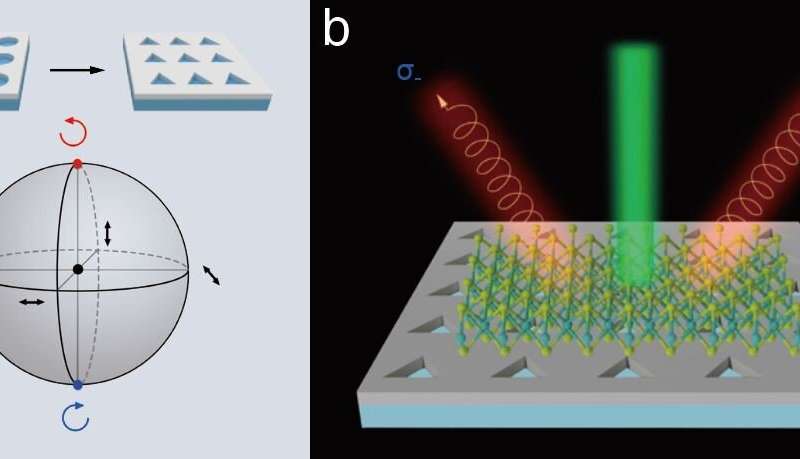#Routing valley exciton emission of a monolayer via in-plane inversion-symmetry broken PhC slabs
“#Routing valley exciton emission of a monolayer via in-plane inversion-symmetry broken PhC slabs”

The valleys of two-dimensional transition metal dichalcogenides (TMDCs) offer a new degree of freedom for information processing and have attracted tremendous interest for their possible applications in valleytronics. To develop valleytronics devices based on TMDCs, effective approaches to separate valleys in the near or far field are indispensable. In recent research, kinds of nanostructures are proposed to separate valleys and much progress has been made.
In a new paper published in Light Science & Applications, a team of scientists, led by Professor Jian Zi, Professor Lei Shi from Fudan University and Professor Tian Jiang from National University of Defense Technology, and co-workers demonstrate that two-dimensional all-dielectric PhC slabs without in-plane inversion symmetry can be used to efficiently separate valley exciton emission of a WS2 monolayer in the far field at room temperature.
Based on circularly polarized delocalized Bloch modes, the valley exciton emission is routed with high directionality and high degree of valley polarization. The delocalized Bloch modes not only play a critical role in separating and enhancing directional valley exciton emission, but also lead to spatial coherence properties of the emission field, which were neglected in the past studies. This property of the PhC slab extends the coherence control on PL of WS2 monolayer from temporal coherence to spatial coherence.
Due to the powerful ability of manipulating light, PhCs have been widely applied in various researches, such as PhC lasers and spontaneous emission control of TMDCs. However, to date, there are no reports of effective valley separation in TMDCs by using PhCs. The scientists introduce their method:

“For the radiative modes of PhC slabs, their polarization states in the far field are strictly defined. However, owing to high rotation symmetry, the polarization field is nearly linear in most PhC slabs. In our recent research, we reported that by breaking in-plane inversion symmetry of PhC slabs, circularly polarized states would emerge in photonic bands. This lays the foundation for us to control valley exciton emission via PhC slabs.”
“Especially, the PhCs’ Bloch modes are delocalized, which would lead to the coherence properties of TMDCs’ emission field. We performed the Young’s double-slit experiment to directly observe the interference fringes.”
“Our method could be extended to manipulate valley exciton emission of other TMDCs monolayers. The ability of this PhC slabs to transport valley information from the near field to the far field would help to develop photonic devices based on valleytronics,” they added.
More information:
Jiajun Wang et al, Routing valley exciton emission of a WS2 monolayer via delocalized Bloch modes of in-plane inversion-symmetry-broken photonic crystal slabs, Light: Science & Applications (2020). DOI: 10.1038/s41377-020-00387-4
Routing valley exciton emission of a monolayer via in-plane inversion-symmetry broken PhC slabs (2020, August 24)
retrieved 24 August 2020
from https://phys.org/news/2020-08-routing-valley-exciton-emission-monolayer.html
This document is subject to copyright. Apart from any fair dealing for the purpose of private study or research, no
part may be reproduced without the written permission. The content is provided for information purposes only.
If you want to read more Like this articles, you can visit our Science category.
if you want to watch Movies or Tv Shows go to Dizi.BuradaBiliyorum.Com for forums sites go to Forum.BuradaBiliyorum.Com

